Related Research Articles

A firearm is any type of gun that uses an explosive charge and is designed to be readily carried and used by an individual. The term is legally defined further in different countries.

A rifle is a long-barreled firearm designed for accurate shooting and higher stopping power, with a barrel that has a helical pattern of grooves (rifling) cut into the bore wall. In keeping with their focus on accuracy, rifles are typically designed to be held with both hands and braced firmly against the shooter's shoulder via a buttstock for stability during shooting. Rifles are used extensively in warfare, law enforcement, hunting and target shooting sports.

In firearm designs, the term single-shot refers to guns that can hold only a single round of ammunition inside and thus must be reloaded manually after every shot. Compared to multi-shot repeating firearms ("repeaters"), single-shot designs have no moving parts other than the trigger, hammer/firing pin or frizzen, and therefore do not need a sizable receiver behind the barrel to accommodate a moving action, making them far less complex and more robust than revolvers or magazine/belt-fed firearms, but also with much slower rates of fire.

Bolt-action is a type of manual firearm action that is operated by directly manipulating the bolt via a bolt handle, which is most commonly placed on the right-hand side of the firearm.
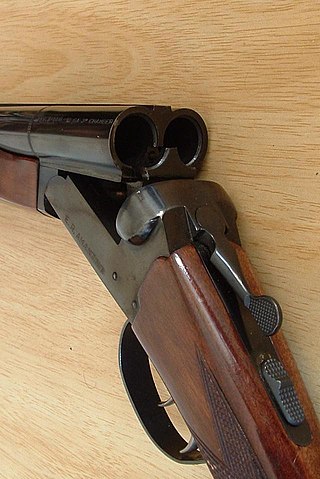
In firearms terminology, an action is the functional mechanism of a breech-loading firearm that handles the ammunition cartridges, or the method by which that mechanism works. Actions are technically not present on muzzleloaders, as all those are single-shot firearms with a closed off breech with the powder and projectile manually loaded from the muzzle. Instead, the muzzleloader ignition mechanism is referred to as the lock.
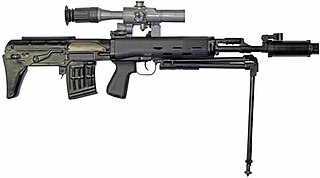
A bullpup firearm is one with its firing grip located in front of the breech of the weapon, instead of behind it. This creates a weapon with a shorter overall length for a given barrel length, and one that is often lighter, more compact, concealable and more maneuverable than a conventionally configured firearm. Where it is desirable for troops to be issued a more compact weapon, the use of a bullpup configuration allows for barrel length to be retained, thus preserving muzzle velocity, range and ballistic effectiveness.

The .50 BMG, also known as 12.7×99mm NATO, and designated as the 50 Browning by the C.I.P., is a .50 in (12.7 mm) caliber cartridge developed for the M2 Browning heavy machine gun in the late 1910s, entering official service in 1921. Under STANAG 4383, it is a standard service cartridge for NATO forces, as well as many non-NATO countries. The cartridge itself has been made in many variants: multiple generations of regular ball, tracer, armor-piercing (AP), incendiary, and saboted sub-caliber rounds. The rounds intended for machine guns are made into a continuous belt using metallic links.
The M14 rifle, officially the United States Rifle, Caliber 7.62 mm, M14, is an American selective-fire battle rifle chambered for the 7.62×51mm NATO cartridge. It became the standard-issue rifle for the U.S. military in 1957, replacing the M1 Garand rifle in service with the U.S. Army by 1958 and the U.S. Marine Corps by 1965. The M14 was used by the U.S. Army, Navy, and Marine Corps for Basic and Advanced Individual Training from the mid-1960s to the early 1970s.
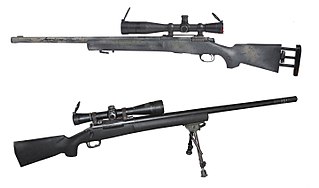
A sniper rifle is a high-precision, long-range rifle. Requirements include high accuracy, reliability, and mobility, concealment, and optics, for anti-personnel, anti-materiel and surveillance uses by military snipers. The modern sniper rifle is a portable shoulder-fired rifle with either a bolt action or semi-automatic action, fitted with a telescopic sight for extreme accuracy and chambered for a high-ballistic performance centerfire cartridge.
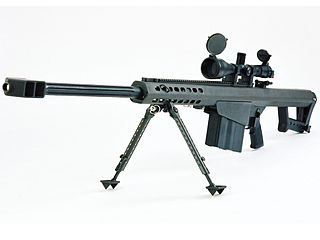
An anti-materiel rifle (AMR) is a rifle designed for use against military equipment, structures, and other hardware (materiel) targets. Anti-materiel rifles are chambered in significantly larger calibers than conventional rifles and are employed to eliminate equipment such as engines and unarmored or lightly armored targets. While modern armored vehicles are resistant to anti-materiel rifles, the extended range and penetration still has many modern applications. While not intended for use against human targets, the bullet weight and velocity of anti-materiel rifles gives them exceptional long-range capability even when compared with designated sniper rifles. Anti-materiel rifles are made in both bolt-action as well as semi-automatic designs.
The Accuracy International Arctic Warfare rifle is a bolt-action sniper rifle designed and manufactured by the British company Accuracy International. It has proved popular as a civilian, police, and military rifle since its introduction in the 1980s. The rifles have some features that improve performance in very cold conditions without impairing operation in less extreme conditions.

The ArmaLite AR-10 is a 7.62×51mm NATO battle rifle designed by Eugene Stoner in the late 1950s and manufactured by ArmaLite. When first introduced in 1956, the AR-10 used an innovative combination of a straight-line barrel/stock design with phenolic composite, a new patent-filed gas-operated bolt and carrier system and forged alloy parts resulting in a small arm significantly easier to control in automatic fire and over 1 lb (0.45 kg) lighter than other infantry rifles of the day. Over its production life, the original AR-10 was built in relatively small numbers, with fewer than 10,000 rifles assembled. However, the ArmaLite AR-10 would become the progenitor for a wide range of firearms.

The Barrett M82 is a recoil-operated, semi-automatic anti-materiel rifle developed by the American company Barrett Firearms Manufacturing.

The QBU-88 sniper rifle is a Chinese bullpup designated marksman rifle developed by Norinco for the People's Liberation Army.

The Barrett M99 is a single-shot anti-materiel rifle that was first introduced in 1999 by the Barrett Firearms Company as a less expensive alternative to the company's higher-priced offerings. The rifle uses a bullpup configuration with a pistol grip.
The Gepárd anti-materiel rifles are a family of Hungarian weapons manufactured by Sero International designed to destroy unarmored and lightly armored targets. These long-range large-caliber rifles have high accuracy and muzzle velocity. In 1987, the Hungarian People's Army sought to obtain a compact, mobile weapon that could damage lightly armored targets. The project, led by Ferenc Földi, culminated in the creation of the Gepárds.
The McMillan TAC-50 is a long-range anti-materiel rifle. The TAC-50 is based on previous designs from the same company, which first appeared during the late 1980s. From May 2017 until November 2023, it held the record for the longest confirmed sniper kill. McMillan makes several .50 caliber rifles, based on the same proprietary action, for military, law enforcement and civilian use. It is produced in Phoenix, Arizona, in the United States by McMillan Firearms Manufacturing.
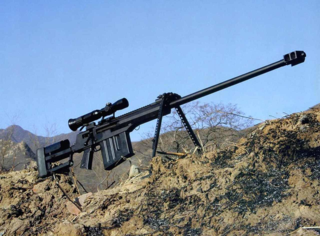
The AMR-2 is a 12.7mm sniper rifle which was developed in China as an anti-materiel sniper weapon, it was introduced in the early 2000s. Designed and developed by Sichuan Huaqing Machinery Co. Ltd, a subsidiary of China South Industries Group, the rifle uses a conventional bolt-action design. The AMR-2 fires a 12.7×108mm cartridge from a 5-round box detachable box magazine fitted directly ahead of the trigger group. The barrel is free-floating and has a large double baffle muzzle brake to mitigate recoil.
The SC-76 Thunderbolt is a bolt-action sniper rifle manufactured by British company Steel Core Designs. It feeds from a detachable box magazine which holds 10 rounds of either .308 Winchester, or more commonly, 7.62x51mm NATO. It costs between $2500 and $3000 per unit and is sold on both the civilian and military markets. Simon Schofield, head of the Security and Defence Division of the Humanitarian Intervention Centre, has described the rifle as "a serious bit of counterterrorism gear and built to be a bit civilian friendly”. The rifle was considered for use by the Indian MARCOS special forces unit, but ultimately rejected in favour of the Tikka T3 by Beretta.
The Desert Tech Hard Target Interdiction (HTI) is a bullpup bolt-action sniper and anti-materiel rifle designed and manufactured in West Valley City, Utah, United States by Desert Tech.
References
- ↑ "Steel Core Designs Cyclone .308W/7.62×51". WMS Firearms Training. Retrieved 9 September 2020.
- 1 2 Vining, Miles (20 June 2017). "British HSR Cyclone anti-materiel rifles in Iraq". Armament Research Services . Retrieved 8 September 2020.
- 1 2 3 "Cyclone". Steel Core Designs. 6 August 2019. Retrieved 10 September 2020.
- ↑ R., Patrick (20 January 2016). "[SHOT 2016] Steel Core Designs Cyclone Long Range Rifle". The Firearm Blog. Retrieved 10 September 2020.
- ↑ "RFD, STEEL CORE RIFLE SALES AND STEEL TARGETS". WMS Firearms Training. Retrieved 10 September 2020.
- ↑ "Cyclone HSR". Steel Core Designs. 16 December 2019. Archived from the original on 2020-07-06. Retrieved 2021-10-14.